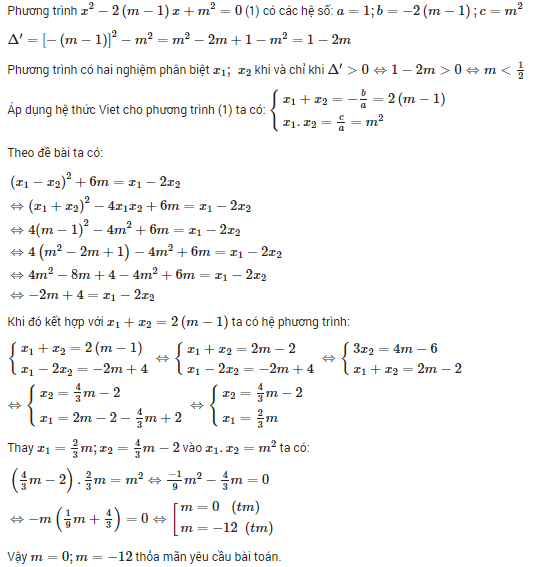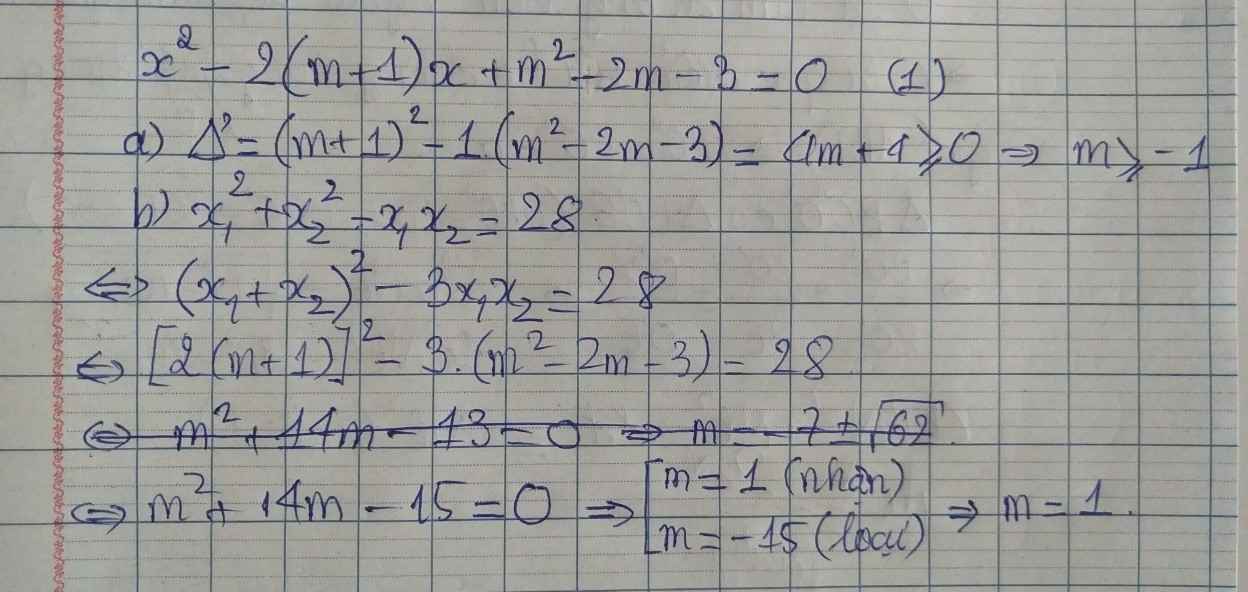Hãy nhập câu hỏi của bạn vào đây, nếu là tài khoản VIP, bạn sẽ được ưu tiên trả lời.

Ta có: \(x^2-4x+m+1=0\)
a=1; b=-4; c=m+1
\(\Delta=b^2-4ac\)
\(=\left(-4\right)^2-4\cdot1\cdot\left(m+1\right)\)
\(=16-4m-4\)
\(=-4m+12\)
Để phương trình (1) có hai nghiệm x1,x2 thì \(\Delta\ge0\)
\(\Leftrightarrow-4m+12\ge0\)
\(\Leftrightarrow-4m\ge-12\)
hay \(m\le3\)
Áp dụng hệ thức Vi-et, ta được:
\(\left\{{}\begin{matrix}x_1+x_2=\dfrac{-b}{a}=\dfrac{-\left(-4\right)}{1}=4\\x_1\cdot x_2=\dfrac{c}{a}=\dfrac{m+1}{1}=m+1\end{matrix}\right.\)
Ta có: \(\left|x_1-x_2\right|=3m-4\)
\(\Leftrightarrow\sqrt{\left(x_1-x_2\right)^2}=3m-4\)
\(\Leftrightarrow\sqrt{\left(x_1+x_2\right)^2-4x_1x_2}=3m-4\)
\(\Leftrightarrow\sqrt{4^2-4\left(m+1\right)}=3m-4\)
\(\Leftrightarrow\sqrt{16-4m-4}=3m-4\)
\(\Leftrightarrow\sqrt{-4m+12}=3m-4\)
\(\Leftrightarrow-4m+12=\left(3m-4\right)^2\)
\(\Leftrightarrow-4m+12=9m^2-24m+16\)
\(\Leftrightarrow9m^2-24m+16+4m-12=0\)
\(\Leftrightarrow9m^2-20m+4=0\)(2)
a=9; b=-20; c=4
\(\Delta=b^2-4ac\)
\(=\left(-20\right)^2-4\cdot9\cdot4=400-144=256\)
Vì \(\Delta>0\) nên phương trình (2) có hai nghiệm phân biệt là:
\(\left\{{}\begin{matrix}m_1=\dfrac{-b-\sqrt{\Delta}}{2a}=\dfrac{20-16}{18}=\dfrac{4}{18}=\dfrac{2}{9}\left(nhận\right)\\m_2=\dfrac{-b+\sqrt{\Delta}}{2a}=\dfrac{20+16}{18}=\dfrac{36}{18}=2\left(nhận\right)\end{matrix}\right.\)
Vậy: \(m\in\left\{\dfrac{2}{9};2\right\}\)

a) Thay m=0 vào phương trình (1), ta được:
\(x^2-2\cdot\left(0-1\right)x+0^2-3m=0\)
\(\Leftrightarrow x^2+2x=0\)
\(\Leftrightarrow x\left(x+2\right)=0\)
\(\Leftrightarrow\left[{}\begin{matrix}x=0\\x+2=0\end{matrix}\right.\Leftrightarrow\left[{}\begin{matrix}x=0\\x=-2\end{matrix}\right.\)
Vậy: Khi m=0 thì S={0;-2}

Lời giải:
Để pt có 2 nghiệm pb thì:
$\Delta'=1-(2-m)=m-1>0\Leftrightarrow m>1$
Áp dụng định lý Viet: \(\left\{\begin{matrix} x_1+x_2=2\\ x_1x_2=2-m\end{matrix}\right.\)
Khi đó:
$2x_1^3+(m+2)x_2^2=5$
$\Leftrightarrow 2x_1^3+(2x_1+2x_2-x_1x_2)x_2^2=5$
$\Leftrightarrow 2(x_1^3+x_2^3)+x_1(2-x_2)x_2^2=5$
\(\Leftrightarrow 2[(x_1+x_2)^3-3x_1x_2(x_1+x_2)]+x_1^2x_2^2=5\)
\(\Leftrightarrow 2[8-6(2-m)]+(2-m)^2=5\)
\(\Leftrightarrow m^2+8m-9=0\Leftrightarrow (m-1)(m+9)=0\)
Vì $m>1$ nên không có giá trị nào của $m$ thỏa mãn.

a,Thay m=2 vào pt :
\(\left(1\right)\Leftrightarrow x^2-4x+3=0\\ \Leftrightarrow\left[{}\begin{matrix}x=1\\x=3\end{matrix}\right.\)
b, Để pt có 2 nghiệm thì \(\Delta'\ge0\)
\(\Leftrightarrow\left(-2\right)^2-1\left(m+1\right)\ge0\\ \Leftrightarrow4-m-1\ge0\\ \Leftrightarrow3-m\ge0\\ \Leftrightarrow m\le3\)
Theo Vi-ét:\(\left\{{}\begin{matrix}x_1+x_2=4\\x_1x_2=m+1\end{matrix}\right.\)
\(x^2_1+x^2_2=5\left(x_1+x_2\right)\\ \Leftrightarrow\left(x_1+x_2\right)^2-2x_1x_2=5.4\\ \Leftrightarrow4^2-2\left(m+1\right)=20\\ \Leftrightarrow16-2m-2-20=0\\ \Leftrightarrow m=-3\left(tm\right)\)
a)Thay \(m=2\) vào (1) ta đc:
\(x^2-4x+2+1=0\Rightarrow x^2-4x+3=0\)
\(\Rightarrow\left(x-3\right)\left(x-1\right)=0\)
\(\Rightarrow\left[{}\begin{matrix}x=3\\x=1\end{matrix}\right.\)
b)Áp dụng hệ thức Viet:
\(\left\{{}\begin{matrix}x_1+x_2=-\dfrac{b}{a}=\dfrac{4}{1}=4\\x_1\cdot x_2=\dfrac{c}{a}=m+1\end{matrix}\right.\) (*)
Theo bài: \(x_1^2+x^2_2=5\left(x_1+x_2\right)\)
\(\Rightarrow\left(x_1+x_2\right)^2-2x_1\cdot x_2=5\left(x_1+x_2\right)\)
\(\Rightarrow4^2-2\cdot\left(m+1\right)=5\cdot4\)
\(\Rightarrow m=-1\)

Để pt có nghiệm \(\Leftrightarrow\Delta\ge0\Leftrightarrow4-4\left(m-1\right)\ge0\)\(\Leftrightarrow2\ge m\)
Theo viet: \(\left\{{}\begin{matrix}x_1+x_2=2\left(1\right)\\x_1x_2=m-1\end{matrix}\right.\)
\(x_1^4-x_1^3=x_2^4-x_2^3\)
\(\Leftrightarrow\left(x_1^4-x_2^4\right)-\left(x_1^3-x_2^3\right)=0\)
\(\Leftrightarrow\left(x_1-x_2\right)\left(x_1+x_2\right)\left(x_1^2+x_2^2\right)-\left(x_1-x_2\right)\left(x_1^2+x_1x_2+x_2^2\right)=0\)
\(\Leftrightarrow\left(x_1-x_2\right)\left[2\left(x_1^2+x_2^2\right)-x_1^2-x_1x_2-x_2^2\right]=0\)
\(\Leftrightarrow\left(x_1-x_2\right)\left(x_1^2+x_2^2-x_1x_2\right)=0\)
\(\Leftrightarrow x_1-x_2=0\) (2) ( vì \(x_1^2-x_1x_2+x_2^2>0;\forall x,y\))
Từ (1) (2) \(\Rightarrow x_1=x_2=1\)
\(\Rightarrow x_1x_2=m-1=1\) \(\Leftrightarrow m=2\) (Thỏa)
Vậy...

a: \(\Delta=\left(2m+2\right)^2-4\left(m^2-2m-3\right)\)
\(=4m^2+8m+4-4m^2+8m+12\)
=16m+16
Để phương trình luôn có nghiệm thì 16m+16>=0
hay m>=-1
b: Theo đề, ta có: \(\left(x_1+x_2\right)^2-2x_1x_2-x_1x_2=28\)
\(\Leftrightarrow\left(2m+2\right)^2-3\left(m^2-2m-3\right)=28\)
\(\Leftrightarrow4m^2+8m+4-3m^2+6m+9=28\)
\(\Leftrightarrow m^2+14m-15=0\)
=>(m+15)(m-1)=0
=>m=1


sửa đề, 2 nghiệm phân biệt nhé
Để pt có 2 nghiệm pb thì \(\Delta>0\)
\(\Delta=16-4\left(-m^2-5\right)=16+4m^2+20=4m^2+36>0\forall m\)
Theo Vi et : \(\hept{\begin{cases}x_1+x_2=-\frac{b}{a}=-4\\x_1x_2=\frac{c}{a}=-m^2-5\end{cases}}\)
mà \(\left(x_1+x_2\right)^2=16\Rightarrow x_1^2+x_2^2=16-2\left(-m^2-5\right)=2m^2+26\)
bình phương 2 hệ thức có dạng \(\left(x_1-x_2\right)^2=16\Rightarrow x_1^2+x_2^2-2x_1x_2=16\)
\(\Leftrightarrow2m^2+26-2\left(-m^2-5\right)=16\)
\(\Leftrightarrow4m^2+36=16\Leftrightarrow4m^2=-20\Leftrightarrow m^2=-5\)vô lí